Litchfield National park is filled with plunge pools, spring-fed streams, waterfalls, and rock holes. The many hiking trails lead through rugged landscape, sandstone escarpments and monsoon rain forests. We spent two full days in the park.
We *free camped just outside the park on our first morning to get an early start. Our first stop was the magnetic termite mounds.
*TIP: WikiCamps is a must for travelers in Australia who want to find free places to camp and points of interest.
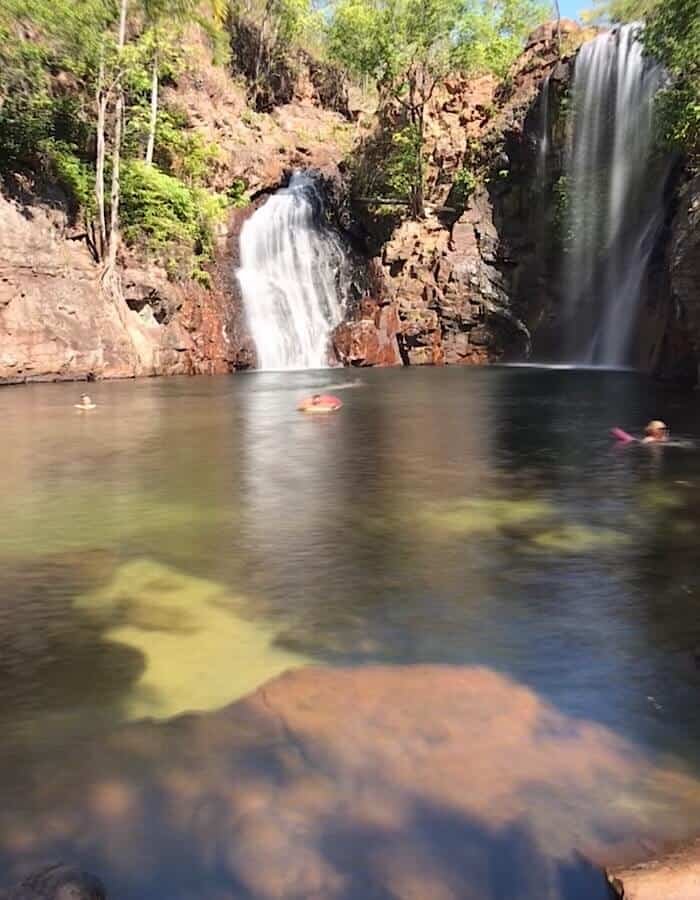
Magnetic termite mounds
The compass termite is endemic to Northern Australia. Their mounds make the grassland look like an ancient cemetery with headstones lined up all facing the same direction. Some of these mounds are around 100 years old.
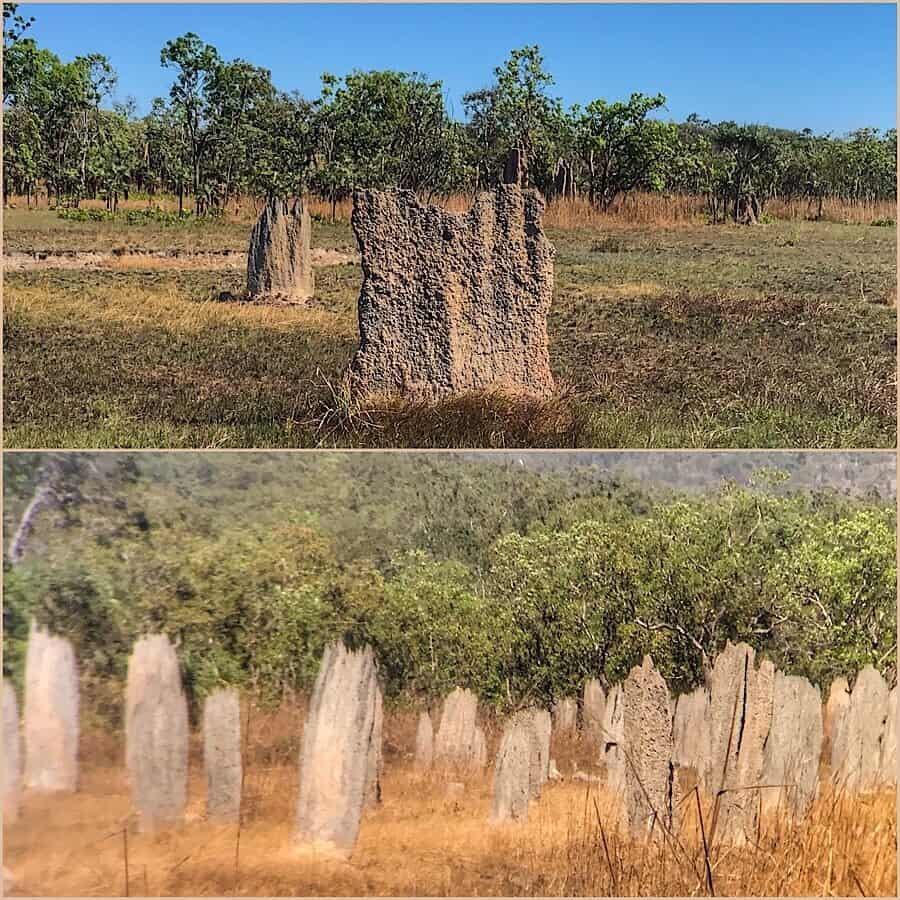
To me, the mounds were fascinating. I loved the beauty of the golden grassland. One early traveler in 1906 had a much different opinion.
“The meridianal ant-hills of the Territory are evidently constructed so that their larger surfaces shall present the least possible area to the sun, and reach the height of 18ft. On the sparsely-grassed flats they favor, and seen through the avenues of miserable and stunted gums, they constitute a new depressant to the outlook.”
-Randolph Bedford, The Brisbane Courier, Saturday 3 February 1906.
Real cheery guy. The quote made me chuckle.
The magnetic termites build large flat mounds with an the axis of their width aligning north – south. Since the termites are blind they can not use the sun as their guide. Scientists believe that they have an internal compass that allows them to build based on the magnetic north-south of the earth. This structure minimizes exposure to the sun and allows the almost translucent little creatures access to the exact temperature within the mounds that they need to survive.
Cathedral Termite mounds
Litchfield is also filled with cathedral termite mounds. Instead of the flat slab-like structures of the compass termite, the cathedral termite mounds are more rounded, almost like turrets of a cathedral joined closely together. These mounds grow tall, some as high as 23 feet (7 meters).
The small gaps inside the “turrets” of a cathedral termite mound are often used by lizards, snakes, and other small animals as shelter from the frequent fires of the grasslands. The mounds are hard as cement but also porous due to the many termite tunnels inside. This provides the perfect insulation against the heat for small creatures.
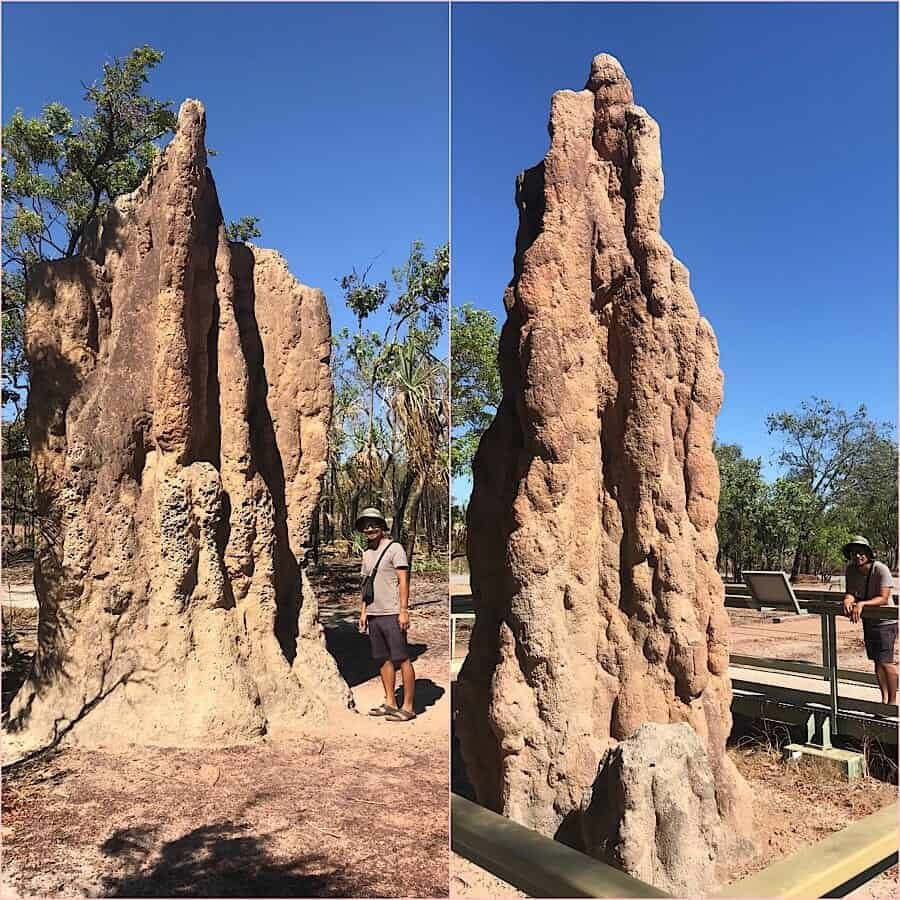
The Wet
The top end of Australia had two seasons, wet and dry. Aboriginal people break it into six seasons including ‘knock ‘em down’ season, the season of violent storms that can knock you down.
During the wet season, often just referred to as “the wet,” many of the plains get flooded and roads become impassable. Some towns become surrounded by water or even completely cut off. Even as far south as Marble Bar, towns can become cut off during the wet. Sandra, our lockdown host during Covid, said that one year Marble Bar was cut off for six weeks due to flood waters.
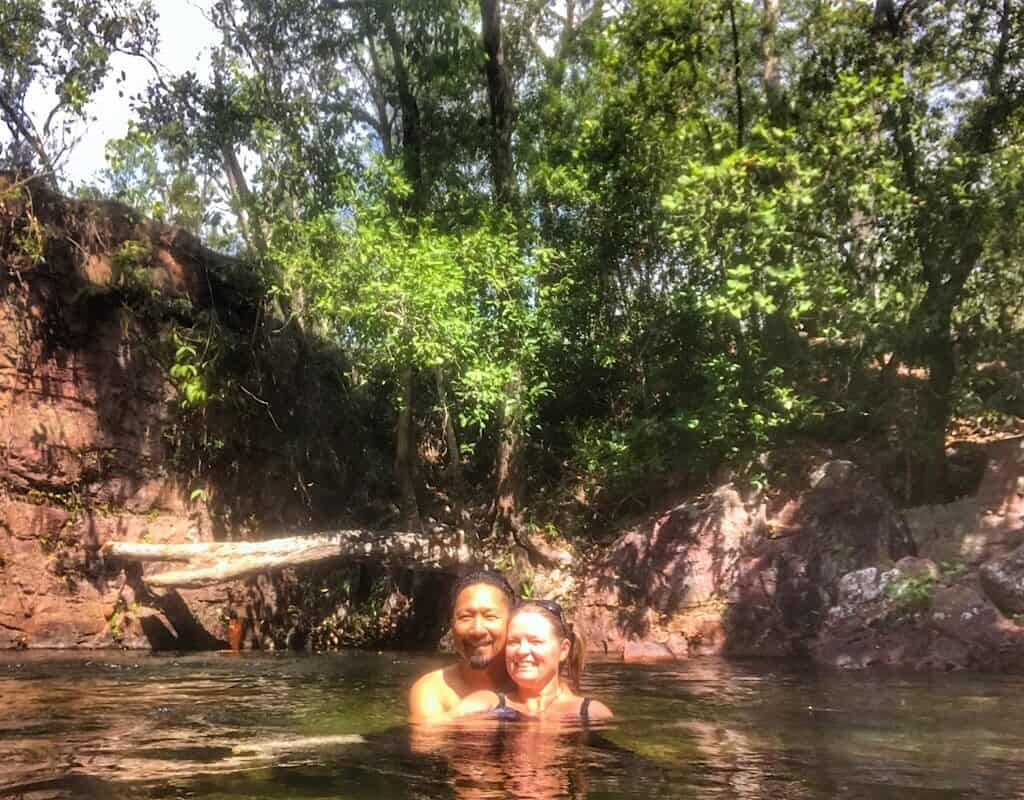
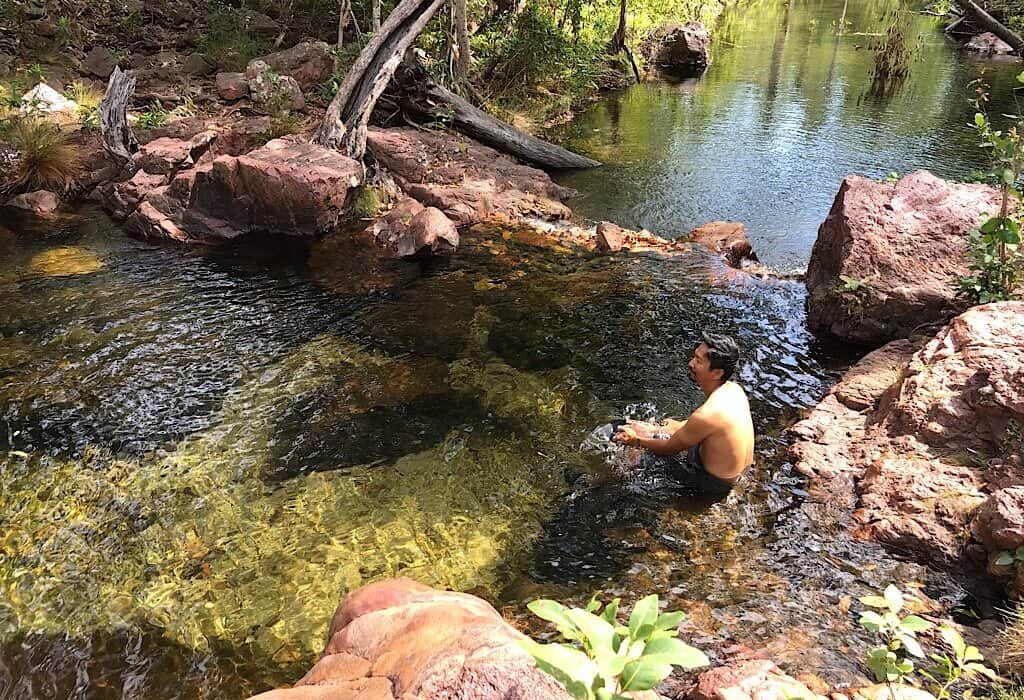
Sandstone tablelands like the one in Litchfield soak up water during the wet and gradually release it throughout the year creating permanent rivers and pools. Since the water has all been filtered through the sandstone the streams are crystal clear.
We took our snorkels into the plunge pool below Florence falls to peer into the depths and watch schools of fish. I also wanted to be aware of any freshies (Freshwater Crocodiles) so that we did not disturb them while swimming.
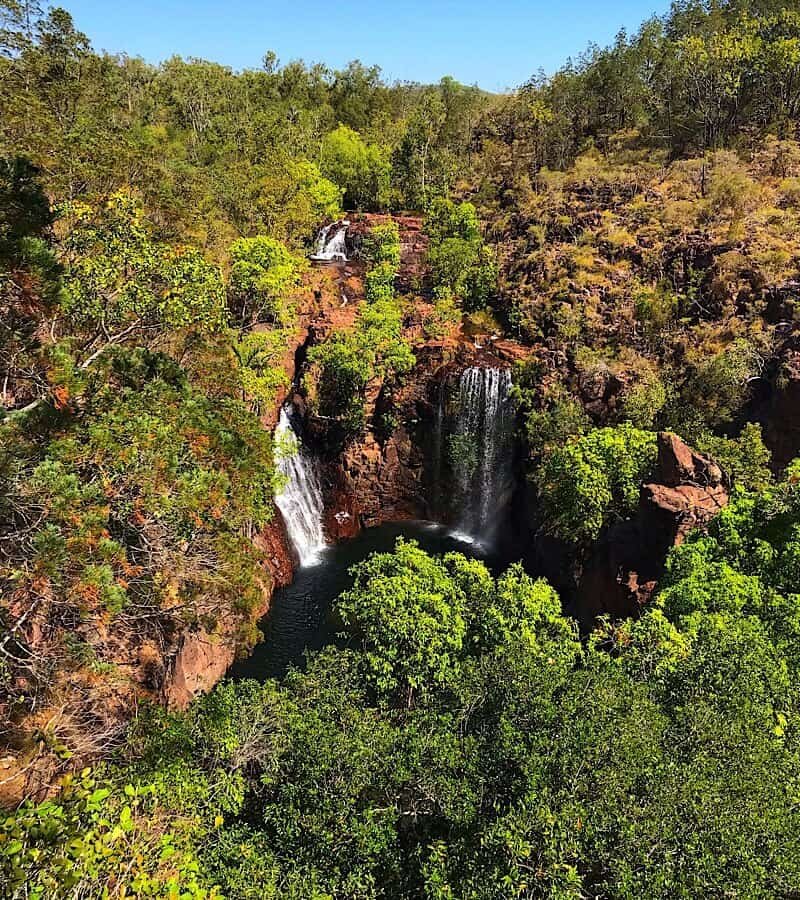
If we held still long enough in the water the fish would come to peck at our legs. We were told that if we held still even longer that they would eventually draw blood. We continued to swim.
The cliffs on our right cast a shadow over the end of the pool that we never found the bottom to. Even with the water being crystal clear the shadows left that end of the pool dark, with depths unknown.
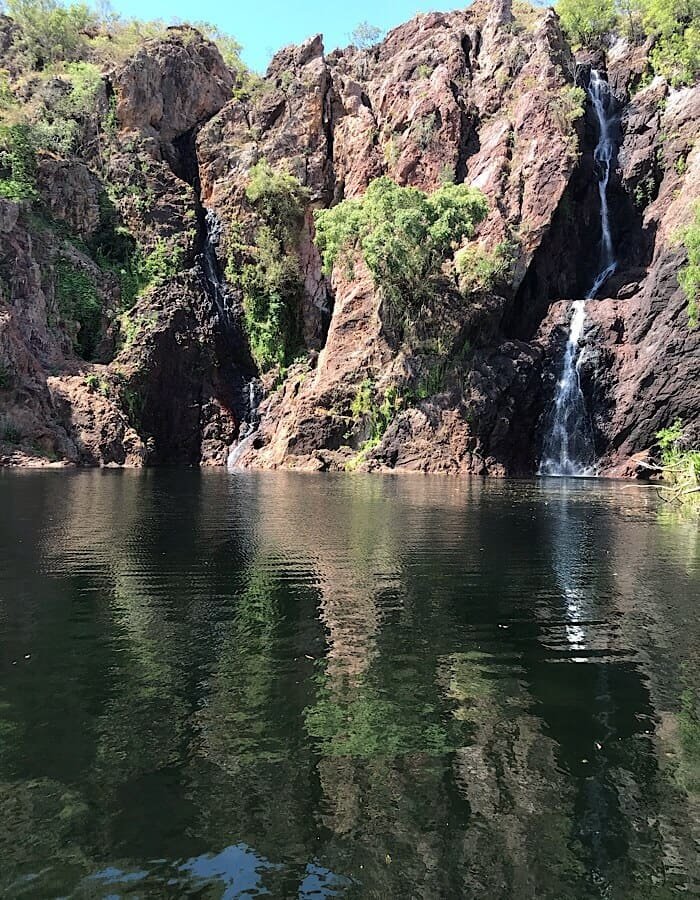
Wangi Falls
From the access point to Wangi falls we swam across the deep plunge pool to the falls on the far side. By climbing partway up the cliff beside one of the waterfalls we found a deep hole in the rocks that created a small endless pool. The water in the hole was over Trin’s head, but when standing in the middle of it he could almost reach every side of the round rock-pool.
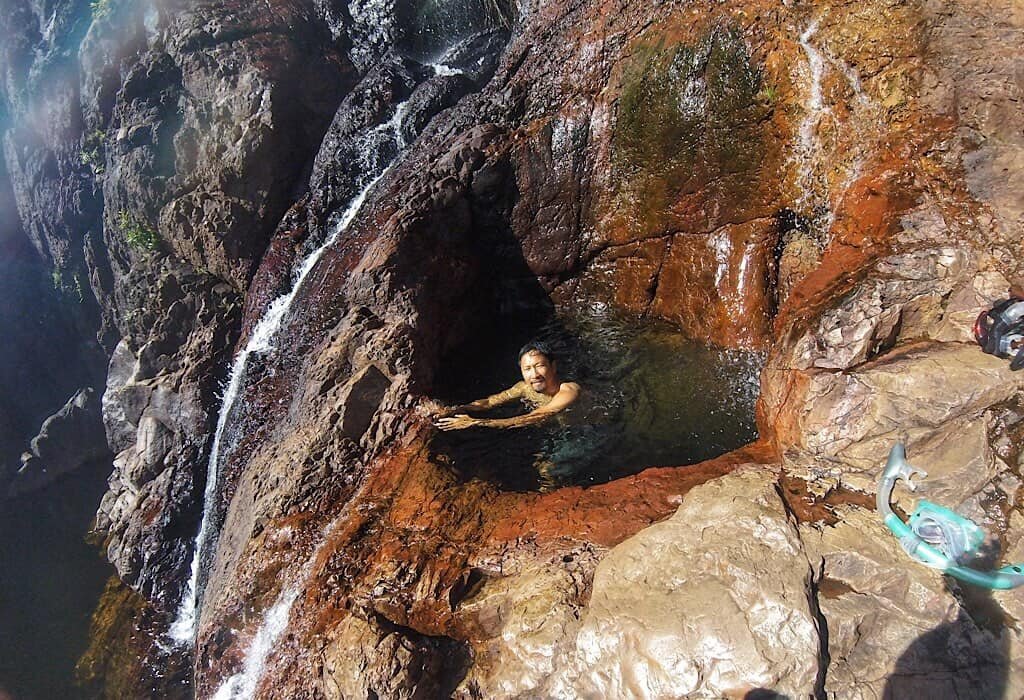
Crocodile warnings
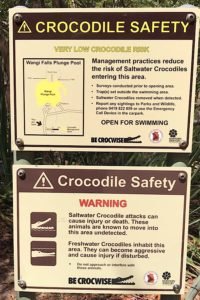
Freshwater crocodiles, called freshies, frequent the waters here but are generally not a threat unless disturnbed. If disturbed they can deliver a nasty bite, but their smaller size reduces the risk of death.
Saltwater crocodiles (aka “salties) are the largest species of crocodiles in the world. They wander into these waters during the wet. Salties are aggressive an attack often result in serious injury or death.
During the wet, swimming is prohibited because of the increased danger of salties and the dangerous currents of the high flood waters. After the wet, park management removes the salties and monitors the waters.
Rangers list the croc risk as low during the dry season. Sometimes a saltie will sneak in undetected so warning signs provide a number to call in case any salties are discovered.
We hiked along Bamboo Creek and stopped along one of the small cascades for a quick dip. Cascades create holes in the sandstone bed and make comfortable recliners where one can sit for a natural massage from the falling waters.
The pool beneath the cascade was about five feet deep and crystal clear. The perfect clarity of the water made it easier to look for freshies and leave them at peace. We didn’t see any near the holes that we swam in.
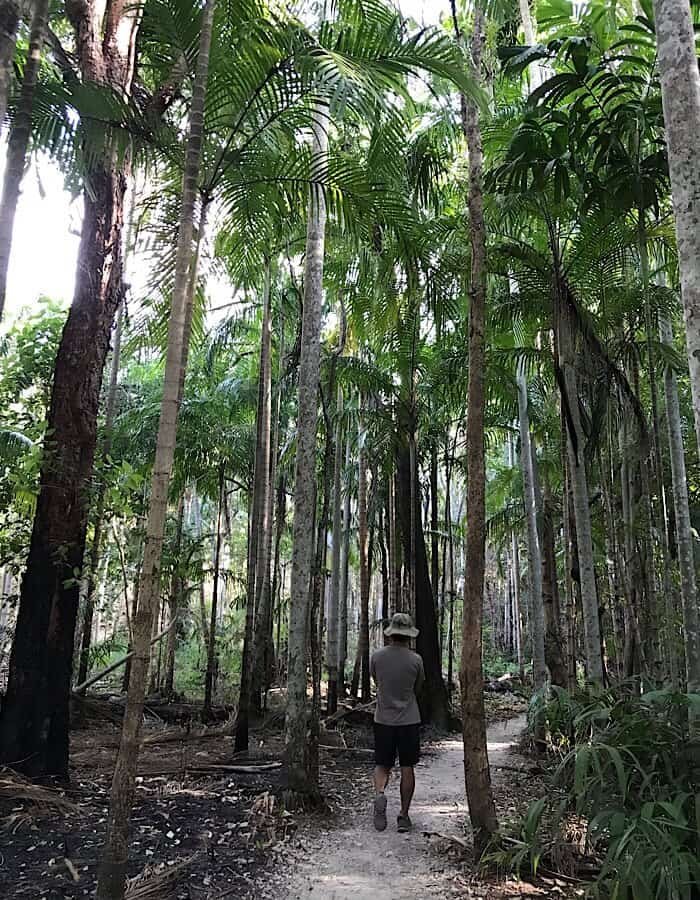
Flying foxes
The base of the sandstone escarpment has access to water year round as the cliffs slowly release the rain from the wet season. This creates pockets for monsoon rain forests to thrive. We hiked from Wangi falls through the rain forests to the top of the escarpment. The environment at the base is so different from the desert top that is covered with low scrub and little shade.
Flying foxes fill the treetops in the monsoon rain forests. They screeched and made such a racket that we could hear them even from the top of the escarpment as we looked down over the forest far below.
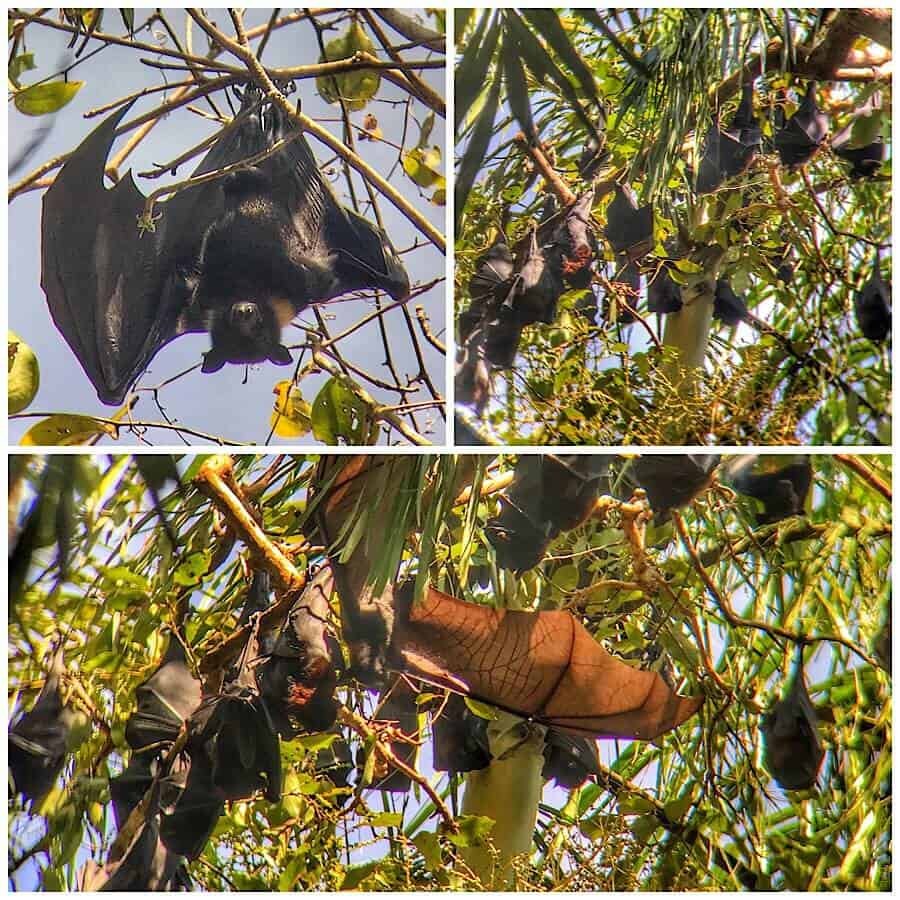
Berry Springs
Berry Springs is another popular waterway between Litchfield and Darwin. The water at Berry Springs is warmer than in Litchfield. From the spring itself we sat under the cascade and then swam down the narrow waterway lined with palms and vegetation. I swam down the narrow passage with a school of fish. At the end of the passage the bottom drops down several meters in depth.
We met Trin’s cousin Simon and his wife Eunice in Berry Springs. They currently live in Darwin, Trin has not seen them for 25 years. We hit it off and ended up camping together that evening, enjoying stories and laughter as the sun set and the stars began to shine.
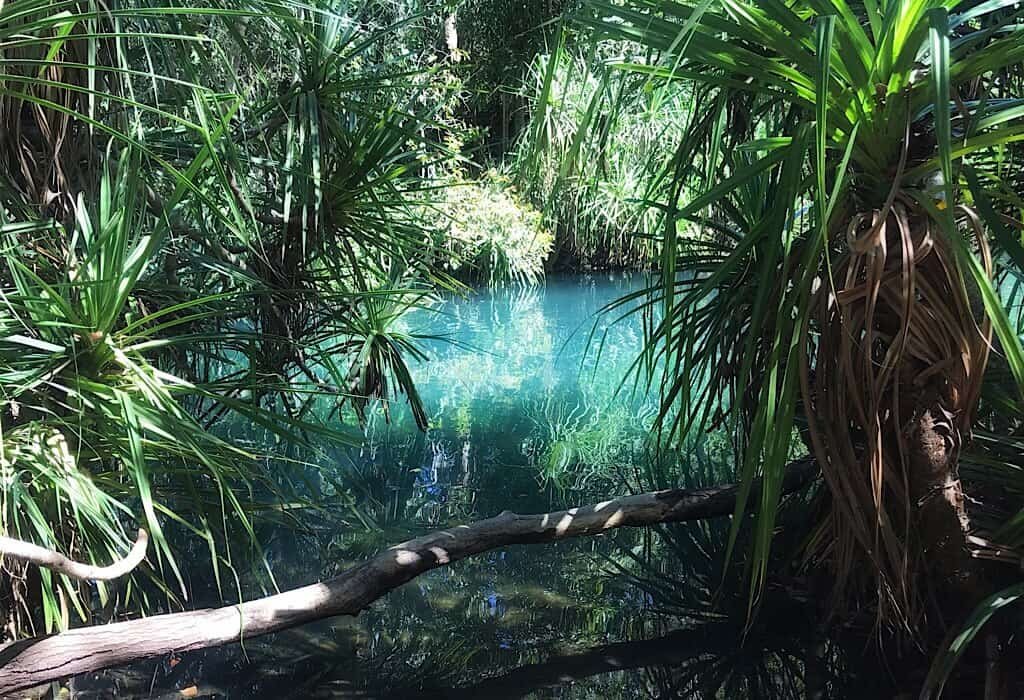
Darwin
Darwin is a pretty little city at the very top of Australia. It is the largest city of the Northern Territory with a population of 132,000. The Northern Territory (NT) is twice the size of Texas, the population of NT less than ¼ of Rhode Island.
The beaches in Darwin are a stunning blue and crystal clear. Swimming is not suggested at most of the beaches in Darwin and during parts of the year it is prohibited. There is a high danger from salties and sharks, but even more from the deadly stingers (jellyfish in Australian).

Eating Ants
We met Simon and Eunice again for lunch at Alexander Lake. The lake is salt water but kept free of salties so that there is a safe place to swim. We sat there enjoying the conversation under the awning next to the lake where kayakers glided by.
“He caught a huge jewel fish,” Simon was telling us a fishing story. “It was really hard to pull it in. He was fighting and the pole was bending. Then suddenly it became easy. He reeled it in. On the end of the line was just the fish head. A shark had eaten the rest during the struggle.”
As we talked Trin picked up a green tree ant that was marching across the picnic table and bit off the abdomen. “Tasty,” he exclaimed.
“Can you find one for me? I have been wanting to try them,” I said. I had just read that they were edible and have a lemony zest.
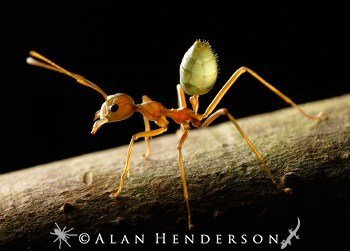
Simon and Eunice watched as we both ate an ant.
“We have lived here one and a half years, no one ever told me we could eat the ants,” Simon said, rather regretfully as if he’d been missing out.
Simon went on the hunt for his own ant. He and I agreed that they do have a nice citrus burst. They were much better than the large roasted ants in Colombia.
Eunice declined to try them.
The green tree ants are beautiful little creatures with an almost translucent green abdomen. They make nests by gluing leaves together. Ants are creatures who have fascinated me on every continent (except Antarctica – I didn’t see any ants there). They clean, till, and harvest with no overseer or ruler. There is wisdom to be learned from the ants and their ways. They are diverse and an important piece of the ecological system.
Maybe your next opportunity won’t be in eating an ant, but it could be a result of learning from the ants. Find your blue door.
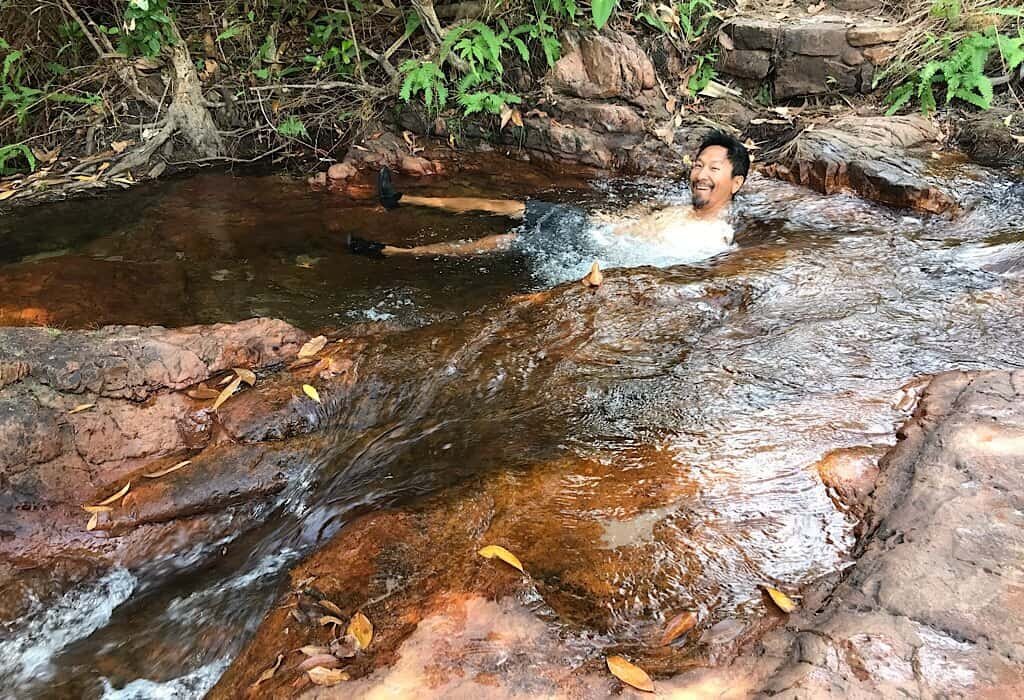


Very interesting but no thanks to swimming with crocs of ANY kind. AND definitely NO to eating ants. That is just gross. Lol
LOL, but Jackie, they were really good!!
No thanks. Lol
Just loving your stories, Bonnie. It made me laugh to picture you eating the ant. It’s you! It brought me back to college when you owned a pet tarantula. I remember [I think it was] Kirsten holding it and she was so nervous and it jumped onto her chest and you laughed hysterically! We all did. Anyway, enjoy these beautiful pictures, nature stories and your application of the ant.
Thank you Priscilla!
Elvira, my tarantula, was beautiful, but she certainly did get great reactions, lol. We had a lot of fun those days, I don’t remember who Elvira jumped on, but I’m sure we had a great laugh.
Bonnie so jealous of this post. We stay at Tumbling Waters every winter and I swim at Berry Springs every day while we are there. Due to Covid and the borders being closed we are not able to be there. Litchfield is beautiful and your photos were great. The territory is a great place unfortunately most Aussies never see it. I hope you also go to the museum and art gallery in Darwin they are fabulous and free. We like to eat at the ski club opposite after going.
Hi Judith, We have thought about you, especially with all that is going on in VIC. Hopefully by next winter this will all be over and you will swim again in Berry Springs.
We are really enjoying the Territory and truly feel blessed to be able to explore it, especially now.
beautiful and very informative photos. I look forward to each of your posts. Especially at this time when my family are gathered around the computer, because of our requests by medical and governmental departments not to go outside or travel.
Thank you, I feel blessed to be in areas where travel is once again being encouraged-at least within state borders. I hope the stories brighten your day. I’m sure it is difficult to stay inside.
Pingback: Kakadu or Kakadon't with 2WD - 43BlueDoors
Great post Bonnie.
Brought back memories of my encounters with Green ants from my time living in Cairns.
We had to pass a shrub full of tiny green ant nests on the path from the driveway to our front door which we would often brush past when carrying our shopping in.
If we ever even just nudged an end leaf or branch on the way past the ants would stresam down the branch and jump on to us ad administer bites to make sure we steered clear the next time. Lesson learnt.
We never thought to eat them, in just the same way we never thought to lick a cane toad!
Speaking of eating ants, have you ever come across Roald Dahl’s poem, ‘The Ant Eater’ ? Its one of my favourite poems!
Have a great weekend
Shaun
I will have to look up that poem and read it. We are headed to Cairns soon, so I’ll watch out for the ants!
I just read the poem lol. Definitely written by a “proper” person who believes that everyone who is different is wrong. Poor spoiled Roy, lol.